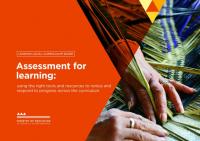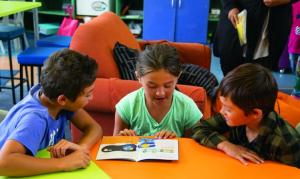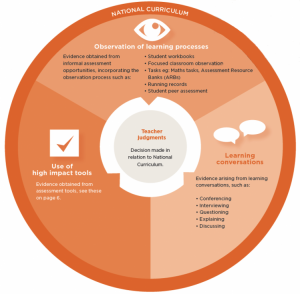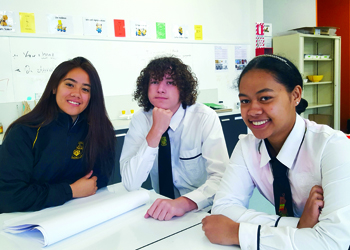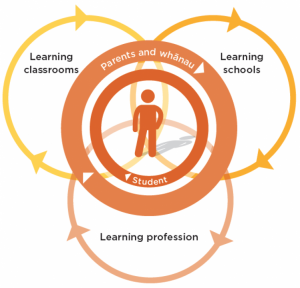Students and teachers use assessment for learning in the classroom
Using assessment information to inform teaching and learning
Assessment tools and resources in support of teacher judgments
This guide focuses on informal assessment for learning in the classroom to inform teaching and learning, including selecting appropriate assessment tools for equitable and positive outcomes for all students. It will support you to review your assessment policies and procedures and can be used for ongoing review.
You can use this guide to lead conversations with your staff – to review your local assessment practices and decide which ones are working well and which can be improved.
It contains guidance, review questions, activities, examples, and resources to enable deep discussions within your school about assessment for learning. The start of the year is a good time to begin conversations with your staff that can continue throughout the year.
Where can you get further support?
The guide series is part of a package, including workshops and tools that will support schools to develop and review local curriculum.
Contact your local Ministry of Education office for support and information.
Mā te whiritahi, ka whakatutuki ai ngā pūmanawa ā tāngata
Together weaving the realisation of potential
Students and teachers use assessment for learning in the classroom
Teachers support learners to notice how they are going with their learning – where they are at, where to next, and whether they know how to get there (knowing who and what can help). Learners can use this personalised feedback to help them set goals and explore any misunderstandings. Teachers can also notice whether there are patterns in the class such as common next steps or misunderstandings and can adjust their teaching accordingly.
Much of this noticing is through the observation of learning processes and in conversations between teachers and learners. Every now and then it is appropriate for teachers to use a high impact assessment tool – one that is well researched and reliable – to guide the next teaching and learning.
These practices are even more important now that our approaches to teaching and learning have become so varied. Inquiry learning, project-based learning, cross-curricular learning, play-based learning – these all require excellent curriculum and assessment knowledge and constant attention to student actions so that teachers are able to "notice, recognise and respond" to the needs of all the students in their care.
Think about these questions as you lead your review
- How well does effective "of the moment" assessment for learning practice underpin teaching and learning in our school?
- Are we over-assessing?
- How well can we locate any student’s performance across the breadth of the curriculum and along a continuum of curriculum levels?
- How are student agency and assessment capability being grown across the school? Can all our students answer the following questions:
- What are you learning?
- Why are you learning it?
- How well are you doing?
- Where do you need to go next?
- How confident are we about the quality of the overall teacher judgments across our school?
- Work in small groups to draw up two lists of the expectations that you would have of students with (a) learner agency and (b) assessment capability. Combine the lists to form a Venn diagram (a diagram showing all possible logical relations between the items) to illustrate and consolidate your shared understandings of the two terms – what they have in common and their differences.
- Now think of specific students you are teaching this year. Use the diagram’s indicators and descriptions of being assessment capable to identify which students are assessment capable and which ones are not? For example, which ones consistently know what they are learning, why, how they are going, and what to do next?
- Think, pair, share: What can you do in your classroom to increase your students’ assessment capability? You may want to design a matching Venn diagram that shows teacher actions.
- Look at what you’ve planned for next week and identify what you could do to support the less assessment-capable students.
Further resources for guidance
Return to top
Using assessment information to inform teaching and learning
Remember who you are assessing for! The primary owners of assessment information are your students.
However, teacher judgments about progress and achievement across the curriculum may be shared with everyone with a stake in using the information. This includes:
- Students
- Teachers
- Parents and whānau
- School leaders
- Boards of Trustees
- Ministry of Education
Good formal teacher judgments are valid (based on what students have learned) and reliable (other teachers would make the same judgment with the same evidence). Teacher judgments should also provide information on what students have learned and the focus of the next learning.
A system that learns
Adapted from ‘Figure 2: Schooling System – a Learning System’, Ministry of Education Position Paper [Schooling Sector] 2011.
Assessment should inform teaching and learning
Give yourself permission to stop those practices that are not contributing to this.
| Assessment as compliance
| Assessment that informs teaching and learning
|
| Progress and achievement are assessed only through the use of assessment tools.
| Sound teacher judgments supported by a reliable assessment tool and ongoing classroom observations and conversations provide information on progress and achievement.
|
| Progressions of learning are not well documented or commonly shared across the teaching staff.
| Progressions of learning are well documented, with exemplars from student work, teacher observations, and assessment tool information. Teachers and students have a shared understanding of progress across levels.
|
| Teacher judgments are not moderated. There are no common understandings of "what good looks like".
| Effective moderation practices establish "what good looks like" at a range of levels. Student exemplars are kept to illustrate different levels of achievement.
|
| Several tools are used to assess progress and achievement within a year level and learning area.
| There is a school-wide plan that reflects the purposeful use of a small number of tools to supplement teacher observations and learning conversations.
|
| There are no standardised procedures across the school for assessment tools.
| Every teacher knows how to administer assessment tools according to the instructions from the tool developer. Teachers have time to discuss procedures.
|
| Assessment is something that is "done" to the students, without their involvement. Students see it as a "test" and something to be worried about.
| Students are involved in assessment processes and they see it as a learning opportunity. They’re motivated to do their best and they look forward to finding out how they’re progressing with their learning. Students discuss with peers, whānau, and teachers where they’re at, what they want to improve on, and how others can help them.
|
| Assessments are carried out at times only to provide information for school leaders or outside providers.
| All assessments are carefully chosen so that they provide valuable information for all stakeholders, particularly students and teachers, that can be acted on.
|
| Analysis of assessment information is done by a select few in the school, and results are presented to teachers.
| Teachers are assessment and analysis capable and take an interest in working with class/cohort data to establish student pathways for learning.
|
Do all assessment practices inform teaching and learning?
- Compare your assessment practices with the list of effective practices in the right-hand column of the table.
- Make a visual representation by drawing up a five-point scale for each of the practices. Each teacher places a dot as to where they think the school sits on the continuum, using a sticky note to explain why.
- Discuss which practices need improvement. Decide on the area to work on first. This could be the one that needs the most work or one that links with other initiatives within the school.
Return to top
Assessment tools and resources in support of teacher judgments
Results from assessment tools are used in conjunction with teacher observations and learning conversations with students, to support teacher judgments.
As a school leader, you should expect to see a reasonably high correlation between teacher judgments and assessment results. There will be differences because of the nature of the assessment processes – these should be investigated to make sure that the judgments are reliable.
It’s important to note that there are not formal assessment tools for all learning areas and the key competencies. Teacher judgments in these areas will be supported by classroom observations, school-developed exemplars, and cross-level and cross-school understandings of progress.
Although schools are free to use whatever tools and resources they choose, there are high impact, well-researched, reliable assessment tools and resources that schools can use to measure progress and achievement. They provide authentic tasks linked to The New Zealand Curriculum that provide rich opportunities for next step learning.
There are guidelines to help you choose the most appropriate assessment tool here:
High impact, well-researched, reliable assessment tools and resources
Each of these tools has a specific purpose which helps with the decisions about why and when you would use the tool. Each tool also provides guidance about how it should be used.
For more information, see Assessment Online – Assessment tools and resources.
It is not expected that all these tools are used for all students all of the time.
| <<< Frequency of use >>>
|
|---|
| More frequent
Purpose: noticing and diagnostic
|
| Less frequent (likely once per year)
Purpose: tracking and monitoring
|
| Running Records
- A framework for systematically observing a student’s reading processing system
| Numeracy Assessment Tools
- NumPA, GloSS, IKAN and JAM
- Four assessments cover Yrs 1–10
| PATs (Progressive Achievement Tests)
- Mathematics and listening comp Yrs 3–10
- Reading comp and vocab Yrs 4–10
- Punctuation and grammar Yrs 4–10
|
|
| Assessment Resource Banks
- English, mathematics, and science for curriculum levels 1–5
| e-asTTle (Electronic Assessment Tools for Teaching and Learning)
- Reading and mathematics Yrs 4–10
- Writing Yrs 1–10
|
|
| An Observation Survey of Early Literacy Achievement (known as the six-year net)
- A set of tasks on basic reading and writing concepts
| Science Assessment Tools from NZCER
- Science: Thinking with Evidence Yrs 7–10
- Junior Science: Thinking with Evidence Yrs 4–6
|
The Learning Progression Frameworks (LPFs) and the Progress and Consistency Tool (PaCT) are curriculum progress tools.
- LPFs describe the significant learning signposts that students reach as they develop their skills in reading, writing, and maths in years 1–10. They provide a big picture illustration of the typical pathways students take as they make progress in reading, writing, and maths.
- PaCT is a tool designed to help teachers make dependable judgments about students’ achievement that can be used to track progress in reading, writing, and mathematics. Teachers and schools can use PaCT to see the progress of a child’s growth against the levels of The New Zealand Curriculum and to help them understand the effectiveness of their local curriculum.
Together, the tools provide valuable information to support teaching and learning conversations and guidance on next steps.
Think about these questions as you lead your review
- How sure are we that all the assessments we use in our school are being used to support teaching and learning?
- In what ways do we involve our students in the assessment process?
- Are we confident in our knowledge of the progress and achievement of our students across the curriculum? Do our students know?
- How confident are we that assessment tools are being administered properly so that the results are reliable? What are our checks on this?
- How sure are we of the effectiveness of the moderation processes used in the school?
- How confidently are our teachers able to analyse assessment data?
- Work in learning area groups or school levels to document the assessment tools that you use to measure progress and achievement.
- Draw up a school-wide map of the resources and tools you use to notice, recognise and respond to progress across the breadth of the curriculum and to support your teacher judgments.
- Agree on what you mean as being high impact assessment tools. Rate the tools you use against this criteria.
- Identify duplicates and/or those that you think should be reviewed or changed.
- Think about the practices associated with tools. Are you over-assessing particular students? Are there better ways to monitor progress?
- Highlight the learning areas where there are few or no assessment tools. Discuss how you might notice and recognise progress and achievement in those areas. Allocate these learning areas to your curriculum leaders for further investigation into progress and achievement.
Example of how Prospect School reviewed their assessment processes
Prospect School – Designing our own approach
The removal of National Standards gave Prospect School in West Auckland the chance to review their assessment processes. They kept what was working for them, discarded what was not, and are in the process of further developing their progressions of learning across the curriculum.
Further resources for guidance
Published on: 27 Nov 2019
Return to top

